DKG307 Automatic Mains Failure Unit
Key Features
- True RMS measurementss
- ECU connection through J1939 CAN option -for CAN version Only
- MPU input option for MPU Version Only
- Dual genset mutual standby operation
- Event logging with time stamp and measurements
- Battery backed-up real-time clock
- Built-in daily/weekly / monthly exerciser
- Weekly operation schedule programs
- Field adjustable parameters
- RS-232 serial port
- Free MS-Windows Remote monitoring SW
- Customer logo display capability
- 10ADC relay outputs
- Configurable analog inputs: 4
- Configurable digital inputs: 7
- Configurable relay outputs: 2
- Total relay outputs: 6
- I/O expansion capability
- Plug-in connection system
- Click Here To Download DKG307 User Manual
₨ 190,000.00 ₨ 220,000.00
Buy all Datakom products like generator controllers, energy meters, panel meters, synchronization controllers, auto mains failures (AMF), auto transfer switches (ATS), etc, online in Pakistan. You can buy DKG307 automatic mains failure unit online or by visiting Electronic Power House (EPH) and Tetralink Technologies (TLT) in Lahore who are the authorized distributor of Datakom in Pakistan. All original Datakom products are available at very reasonable and best prices in Pakistan.
Features
- True RMS measurementss
- ECU connection through J1939 CAN option -for CAN version Only
- MPU input option for MPU Version Only
- Dual genset mutual standby operation
- Event logging with time stamp and measurements
- Battery backed-up real-time clock
- Built-in daily/weekly / monthly exerciser
- Weekly operation schedule programs
- Field adjustable parameters
- RS-232 serial port
- Free MS-Windows Remote monitoring SW
- MODBUS communications
- 10ADC relay outputs
- Configurable analog inputs: 4
- Configurable digital inputs: 7
- Configurable relay outputs: 2
- Total relay outputs: 6
- I/O expansion capability
- Plug-in connection system
Description
The controller is a comprehensive AMF unit for single genset standby or dual genset mutual standby operations.
The unit is available with MPU or CANBUS versions. The CANBUS version connects to ECU controlled electronic engines providing engine control,
protection and instrumentation without extra senders. The unit is able to initiate modem calls and send SMS messages in fault conditions through external modems.
The unit provides a comprehensive set of digitally adjustable timers, threshold levels, input and output configurations, operating sequences and engine
types. All programs may be modified via front panel pushbuttons, and do not require an external unit. Last 100 faults are stored in the event log file. The event log includes not only the date-time information, but also a comprehensive list of measured genset parameters at the time that the fault has occurred. The WINDOWS based RAINBOW program allows remote monitoring and control. The unit supports MODBUS protocol enabling communication with PLCs and building management systems.
Introduction To The Control Panel
The unit is a control and protection panel used in gensets. It shows the measured values on its displays. The unit is designed to provide user friendliness for both the installer and the user. Programming is usually unnecessary, as the factory settings have been carefully selected to fit most applications. However programmable parameters allow the complete control over the generating set. Programmed parameters are stored in a Non Volatile Memory and thus all information is retained even in the event of complete loss of power.
The measured parameters are:
Mains voltage phase L1 to neutral
Mains voltage phase L2 to neutral
Mains voltage phase L3 to neutral
Mains voltage phase L1-L2
Mains voltage phase L2-L3
Mains voltage phase L3-L1
Gen voltage phase L1 to neutral
Gen voltage phase L2 to neutral
Gen voltage phase L3 to neutral
Gen voltage phase L1-L2
Gen voltage phase L2-L3
Gen voltage phase L3-L1
Gen current phase L1
Gen current phase L2
Gen current phase L3
Gen frequency
Engine speed (rpm)
Gen total kW
Gen total pf
Battery voltage,
Coolant temperature
Oil pressure
Oil temperature
Fuel level
Mounting The Unit
The unit is designed for panel mounting. The user should not be able to access parts of the unit other than the front panel.
Mount the unit on a flat, vertical surface. Before mounting, remove the mounting brackets and connectors from the unit, then pass the unit through the mounting opening. The unit will be maintained in its position by the mounting brackets spring.
*Engine body must be grounded for correct operation of the unit, otherwise incorrect voltage and frequency measurements may occur.
The output of the current transformers shall be 5 Amperes. The input current rating of the current transformers may be selected as needed (between 10/5 and 9000/5 amps). Current transformer outputs shall be connected by separate cable pairs from each transformer, to related inputs. Never use common terminals or grounding. The power rating of the transformer should be at least 5 VA. It is recommended to use 1% precision transformers.
If analogue senders (e.g. temperature, oil pressure or fuel level) are connected to the unit, it is not possible to use auxiliary displays, otherwise the unit may be damaged. If temperature or oil pressure or fuel level displays are already present on the generator control panel, do not connect the senders to the unit. The unit is factory programmed for VDO type senders. However different types of senders are selectable via programming menu. Please check the programming section.
The programmable digital inputs are compatible with both normally open and normally closed contacts, switching either to BAT- or BAT+.
The charge alternator connection terminal provides also the excitation current, thus it is not necessary to use an external charge lamp.
Wiring The Unit

Alarms & Warnings
Alarms indicate an abnormal situation in the generating set are divided into 3 priority levels:
1- ALARMS: These are the most important fault conditions and cause:
– Therelated ALARM led to be on steadily,
– The genset contactor to be released immediately,
– The engine to be stopped immediately,
– The Horn, Alarm, Alarm+Load_dump and Alarm+Load_dump+Warning digital outputs to operate, (if selected via programming menu)
2- LOAD_DUMPS: These fault conditions cause:
– Therelated ALARM led to be on steadily,
– The genset contactor to be released immediately,
– The engine to be stopped after Cooldown period,
– The Horn, Alarm+Load_dump and Alarm+Load_dump+Warning digital outputs to operate, (if selected via programming menu)
3- WARNINGS: These conditions cause:
– Therelated ALARM led to flash,
– The Horn and Alarm+Load_dump+Warning digital outputs to operate, (if selected via programming menu)
If the ALARM MUTE button is pressed, the Horn output will be deactivated; however the existing alarms will persist and disable the operation of the genset.
Alarms operate in a first occurring basis:
-If an alarm is present, following alarms, load_dumps and warnings will not be accepted,
-If a load_dump is present, following load_dumps and warnings will not be accepted,
-If a warning is present, following warnings will not be accepted.
Alarms may be of LATCHING type following programming. For latching alarms, even if the alarm condition is removed, the alarms will stay on and disable the operation of the genset. The existing alarms may be canceled by pressing one of the operating mode buttons (LOAD TEST / TEST / OFF / AUTO).
Most of the alarms have programmable trip levels. See the programming chapter for adjustable alarm limits.
LOW OIL PRESSURE: Set if a signal is detected at the Low Oil Pressure Switch input or the oil pressure value measured from the sender is below the programmed limit. Warning and alarm limits are separately programmable for the oil pressure sender input. This fault will be monitored with Holdoff Timer delay after the engine is running. Also if the oil pressure switch is open at the beginning of a start attempt, then the engine will not be started and the oil pressure alarm led will flash. When the oil pressure switch closes, normal operation will be resumed.
HIGH TEMPERATURE: Set if a signal is detected at the High Temperature Switch input or the coolant temperature value measured from the sender is above the programmed limit. Warning and alarm limits are separately programmable for the temperature sender input.
LOW TEMPERATURE (warning) : Set if the coolant temperature value measured from the sender is blow the Engine Heating Temperature limit.
LOW SPEED / HIGH SPEED: Set if the generator frequency or rpm is outside programmed limits. These faults will be monitored with Holdoff Timer delay after the engine is running. Low and high limits for warning and alarm are separately programmable. Another high shutdown limit which is 12% above the high limit is always monitored and stops the engine immediately.
START FAIL (alarm): Set if the engine is not running after programmed number of start attempts.
STOP FAIL (warning): Set if the engine has not stopped before the expiration of the Stop Timer.
ECU FAIL (warning): Set when an engine fault code is received from the ECU of the electronic engine. This fault will not cause an engine stop. If necessary, the engine will be stopped by the ECU.
ECU FAIL (alarm): Set if no information has been received during 3 seconds from the ECU of the electronic engine. This fault condition is only controlled if fuel is on.
OVERLOAD (load_dump): Set if at least one of the genset phase currents goes over the Overcurrent Limit for Overload Timer. If currents go below the limit before expiration of the timer then no alarm will be set.
EXCESS POWER (load_dump): Set if the genset power (KW) supplied to the load goes over the Excess Power limit for Overload Timer. If the power goes below the limit before expiration of the timer then no alarm will be set.
GENSET LOW VOLTAGE: Set if any of the generator phase voltages goes outside programmed limits for Overload Timer. This fault will be monitored with holdoff timer delay after the engine is running.
GENSET HIGH VOLTAGE: Set if any of the generator phase voltages goes outside programmed limits for Overload Timer. This fault will be monitored with holdoff timer delay after the engine is running.
LOW COOLANT LEVEL: Set if a signal is detected at the low coolant level input.
HIGH BATTERY VOLTAGE: Set if the battery voltage goes above programmed limits. Both warning and alarm levels for high battery voltage are programmable.
LOW BATTERY VOLTAGE (warning): Set if the battery voltage goes below the programmed limit. During engine cranking this fault is not monitored.
CHARGE: Set if a charge alternator failure (or broken belt) occurs. This fault condition may result to a warning or alarm following programming.
RECTIFIER FAIL: Set if a signal is detected at the rectifier fail input. This input is only monitored when mains voltages are present.
EMERGENCY STOP: Set if a signal is detected at the emergency stop input.
SPARE: Set if a signal is detected from the related spare fault input.
Modes Of Operation
The modes of operation are selected by pushing the front panel keys. Changing the operation mode while the genset is running will result into a behavior suitable for the new operating mode. For example, if the TEST mode is selected when genset is running at RUN mode, then the genset will take the load.
STOP: In this mode, the mains contactor will be energized if mains phase voltages are within the programmed limits. The engine will be stopped.
AUTO: It is used for genset and mains automatic transfer. If at least one of the mains phase voltages is outside limits, the mains contactor will be deactivated.
The diesel will be started for programmed times after the preheat timer. When the engine runs, the crank relay will be immediately deactivated. The engine will run without load during engine heating period. After this, if alternator phase voltages and frequency are within limits, then the unit will wait for the generator contactor period and the generator contactor will be energized.
When all the mains phase voltages are within the limits, the engine will continue to run for the mains waiting period. At the end of this period the generator contactor is deactivated and the mains contactor will be energized. If a cooldown period is given, the generator will continue to run during cooldown period. At the end of the period, the fuel solenoid will be de-energized and the diesel will stop. The unit will be ready for the next mains failure.
If the operation of the genset is disabled by the weekly schedule, then the AUTO led will flash, and the operation of the genset will be as in the OFF mode.
RUN: It is used to test the generator when the mains are on, or keep the generator running in the emergency backup mode. The operation of the generator is similar to the AUTO mode, but the mains contactor will not be deactivated if the mains are not off. If the mains are off, mains contactor will be deactivated and the generator contactor will be activated. When the mains are on again, a changeover to the mains will be made, but the engine will be kept running unless another mode is selected. To stop the engine, select AUTO or OFF mode.
TEST: It is used to test the genset under load. Once this mode is selected, the engine will run and the load will be transferred to the genset. The genset will feed the load indefinitely unless another mode is selected.
Programming
* For Programming the Unit See User Manual of DKG307
Connection Diagram

Click Here To Download DKG307 User Manual
Technical Specifications
| brands | DATAKOM |
|---|---|
| color | Black |
Technical Specifications
Alternator voltage: 0 to 300 V-AC Phase to Neutral (0 to 520 V-AC Phase to Phase)
Alternator frequency: 0-100 Hz.
Mains voltage: 0 to 300 V-AC Phase to Neutral (0 to 520 V-AC Phase to Phase)
Mains frequency: 0-100 Hz.
DC Supply range: 9.0 VDC to 33.0 VDC
Cranking dropouts: survives 0 V for 100ms
Typical stand-by current consumption: 100 mADC.
Maximum current consumption: 250 mADC.
Generator/mains contactor outputs: 16 A @ 250 VAC.
DC outputs: 10A @ 28 VDC. relay outputs.
Charge alternator excitation: min 2W.
Magnetic pickup input:: 0.5 ? 30 V-AC.
Magnetic pickup frequency: 10 KHz max.
Current inputs: from current transformers, …/5A. Max load 0.7VA per phase.
Digital inputs: input voltage 0 – 30 VDC. Internally connected to battery positive via 47?000 ohm resistor.
Analog inputs: Resistor input 0 to 5000 ohms connected to the battery negative. Sources 5 mA when closed to battery negative.
Measurement category: CAT II
Air category: Pollution degree II
Communication port: RS-232. 9600 bauds, no parity, 1 stop bit.
Operating temperature range: -40?C to +70?C (-40 ?F to +158 ?F)
Storage temperature range: -55?C to +80?C (-67?F to +176?F)
Maximum humidity: 95%, non-condensing
Dimensions: 172x134x46mm (WxHxD)
Panel Cut-out dimensions: 151 x 111mm minimum.
Weight: 340 g (approx.)
Case material: High temperature, self extinguishing ABS/PC (UL94-V0)
IP protection: IP65 from front panel, IP30 from the rear


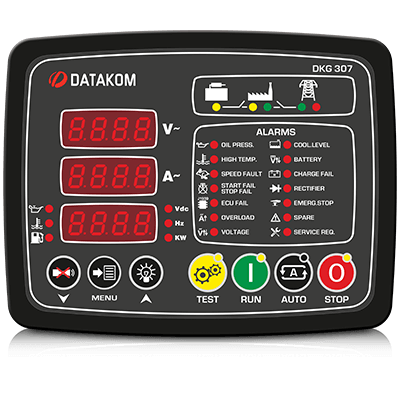

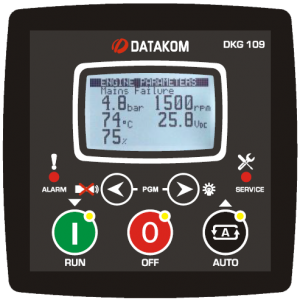
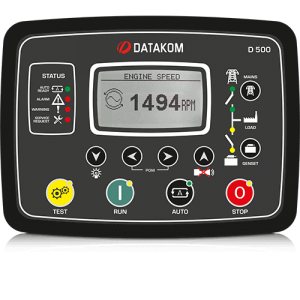
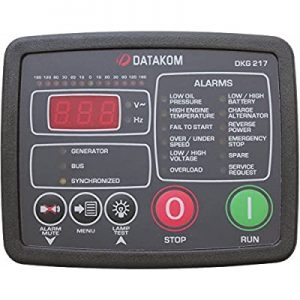
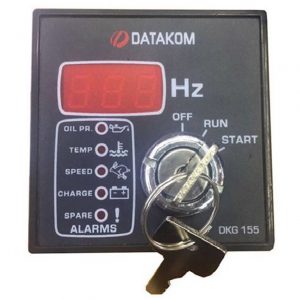
There are no reviews yet.